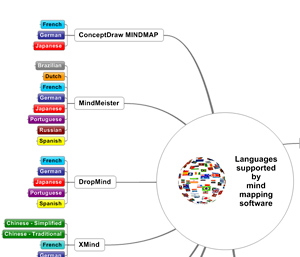 It’s easy, sitting here in the middle of one of the world’s largest English-speaking countries, to assume that mind mapping software in English works for everyone. But the fact is it doesn’t. One look at the results of my Twitter searches for the terms “mindmap” and “mind map” confirm that there are large numbers of people around the world working with mind maps who don’t speak English.
It’s easy, sitting here in the middle of one of the world’s largest English-speaking countries, to assume that mind mapping software in English works for everyone. But the fact is it doesn’t. One look at the results of my Twitter searches for the terms “mindmap” and “mind map” confirm that there are large numbers of people around the world working with mind maps who don’t speak English.
That’s why I recently scanned the websites of the major mind mapping software developers, to see which languages their programs support. The results of my informal research can be found in the mind map above right. The results are color coded by country; please click on the image to view a larger version.
I developed this list by perusing the websites and support forums of the software developers. If I missed anyone, I apologize – it simply means that your mention of these capabilities wasn’t immediately obvious. Please feel welcome to post your additions and corrections to the comments area below.
One thing that surprised me was the large number of programs that don’t appear to support languages other than English. I think they’re doing themselves and their potential customers a major disservice. But I also understand the enormous time and expense that must be involved in rewriting thousand of lines of code just to support other languages and character sets, with no guarantee that this investment will pay off.
If you look at the mind map of language localizations, one of the first things you’ll notice is that FreeMind, the open-source mind mapping program, supports an enormous number of languages. This is accomplished by downloading a separate resource file, which you must copy and paste into the same directory into which you install FreeMind. Not terribly hard for intermediate or advanced computer users, but probably more than a beginner would want to mess with.
Still, it’s a clever way to address this challenge – don’t create dozens of localized versions of your program, each with a slightly different code base. Rather, publish one program, and then supply configuration files that load the proper character sets and translate the program’s toolbars into the language desired.

Leave a Reply